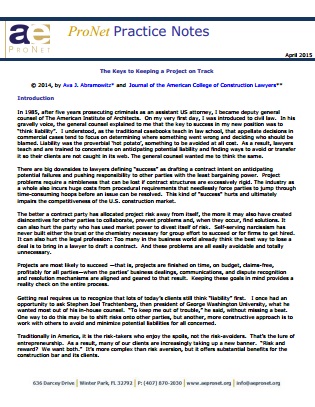 In 1985, after five years prosecuting criminals as an assistant US attorney, I became deputy general counsel of The American Institute of Architects. On my very first day, I was introduced to civil law. In his gravelly voice, the general counsel explained to me that the key to success in my new position was to “think liability”. I understood, as the traditional casebooks teach in law school, that appellate decisions in commercial cases tend to focus on determining where something went wrong and deciding who should be blamed. Liability was the proverbial ‘hot potato’, something to be avoided at all cost. As a result, lawyers teach and are trained to concentrate on anticipating potential liability and finding ways to avoid or transfer it so their clients are not caught in its web. The general counsel wanted me to think the same.
In 1985, after five years prosecuting criminals as an assistant US attorney, I became deputy general counsel of The American Institute of Architects. On my very first day, I was introduced to civil law. In his gravelly voice, the general counsel explained to me that the key to success in my new position was to “think liability”. I understood, as the traditional casebooks teach in law school, that appellate decisions in commercial cases tend to focus on determining where something went wrong and deciding who should be blamed. Liability was the proverbial ‘hot potato’, something to be avoided at all cost. As a result, lawyers teach and are trained to concentrate on anticipating potential liability and finding ways to avoid or transfer it so their clients are not caught in its web. The general counsel wanted me to think the same.
There are big downsides to lawyers defining “success” as drafting a contract intent on anticipating potential failures and pushing responsibility to other parties with the least bargaining power. Project problems require a nimbleness that can be lost if contract structures are excessively rigid. The industry as a whole also incurs huge costs from procedural requirements that needlessly force parties to jump through time-consuming hoops before an issue can be resolved. This kind of “success” hurts and ultimately impairs the competitiveness of the U.S. construction market.
The better a contract party has allocated project risk away from itself, the more it may also have created disincentives for other parties to collaborate, prevent problems and, when they occur, find solutions. It can also hurt the party who has used market power to divest itself of risk. Self-serving narcissism has never built either the trust or the chemistry necessary for group effort to succeed or for firms to get hired. It can also hurt the legal profession: Too many in the business world already think the best way to lose a deal is to bring in a lawyer to draft a contract. And these problems are all easily avoidable and totally unnecessary.
Projects are most likely to succeed —that is, projects are finished on time, on budget, claims-free, profitably for all parties—when the parties’ business dealings, communications, and dispute recognition and resolution mechanisms are aligned and geared to that result. Keeping these goals in mind provides a reality check on the entire process.
Getting real requires us to recognize that lots of today’s clients still think “liability” first. I once had an opportunity to ask Stephen Joel Trachtenberg, then president of George Washington University, what he wanted most out of his in-house counsel. “To keep me out of trouble,” he said, without missing a beat. One way to do this may be to shift risks onto other parties, but another, more constructive approach is to work with others to avoid and minimize potential liabilities for all concerned.
Traditionally in America, it is the risk-takers who enjoy the spoils, not the risk-avoiders. That’s the lure of entrepreneurship. As a result, many of our clients are increasingly taking up a new banner. “Risk and reward? We want both.” It’s more complex than risk aversion, but it offers substantial benefits for the construction bar and its clients.
To help understand where our clients are going, it’s instructive to see where they have been. For many years, their lawyers, insurance carriers and risk managers have told them to run from risk. They doubt whether they have the experience or resources to manage risks on their own, and they jump at the opportunity to protect themselves by “word-smithing” and by purchasing insurance, or requiring someone else to purchase insurance. Enormous sums have been spent on buying overlapping bonds and insurance policies, while attorneys draft indemnity clauses by which clients are protected even against their own passive negligence. Through these various contractual vehicles, our clients have managed their risks by having us lawyers manage their words.
But knee-jerk risk transferring can come at a cost. Some clients have had to rethink that approach, when they find that the market for their services was shrinking due either to their refusal to take responsibility for their own actions or because their own customers were demanding their own one-sided risk transfers. Experienced clients began to realize that it could be more rewarding for them to actively manage the reasonable risks rather than running away from them. In embracing and managing risk, a profit could be made.
The bottom line was simple, although getting there might be difficult. More money could come to those who analyzed exposures with logic and without fear, determined who was the most capable of managing the exposure, and then made sure that that entity received all the resources it reasonably needed to manage the risk successfully – both authority and fee.
The transition from risk avoidance to risk management may entail some cost. But risk-managing clients also recognized offsetting savings from failures prevented, litigation avoided, transaction costs escaped, and opportunities gained through projects completed on time and on budget. To the question, “Wouldn’t all parties to the design and construction process be better off in the long run if funds spent on avoiding liability or disputing it actually went into the project to help it succeed,” many of them joined in a resounding “Yes.”
Representing those enlightened clients, ever growing in number, presents a challenge to the construction bar today. How can lawyers trained in risk-avoidance shift to a focus on risk management so that clients can remain competitive? The first step is getting our clients to understand that enlarging their exposure to risk should ultimately reduce the chances of their being found liable, if they manage the risks they assume reasonably and well. They may even increase their profits in the process. After all, if increased responsibilities are handled effectively, the probabilities of something going wrong should decrease. And the problems that do arise should be resolved more promptly and more equitably.
Novartis, its architects, engineers, contractors, and subcontractors took just that approach when converting its old 550,000 square foot NECCO candy factory into an award-winning, state-of-the art, research laboratory. Novartis brought that multi-million dollar conversion project in on time and below budget, without one injured worker, and using Integrated Project Delivery (IPD) and Building Information Modeling (BIM). The contractual tools included a focus on sharing the incentives and rewards for success, accompanied by strong project governance that recognized the need for party flexibility, and even stronger party communication skills. Let’s consider these points one by one.
This has been an excerpt of our most recent ProNet Practice Note titled The Keys to Keeping a Project on Track. Visit the a/e ProNet website to download the full PDF version of this excellent, in-depth white paper. If you have questions or would like to receive these newsletters when they are published, contact your local a/e ProNet broker today!
About the Author
A former assistant US attorney for the District of Columbia, Ava J. Abramowitz mediates and teaches negotiations at George Washington University Law School. She is the author of The Architect’s Essentials of Negotiation (John Wiley & Sons 2009) and is the 2008 recipient of the ABA Forum on Construction Industry’s Cornerstone Award.
This article has been reprinted with permission from the American College of Construction Lawyers, after first appearing in the Journal of the American College of Construction Lawyers 43 (Summer 2014).



